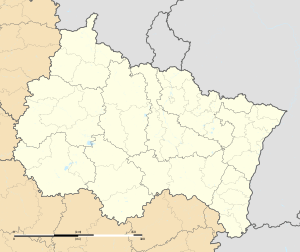Grendelbruch
Grendelbruch is a commune in the Bas-Rhin department in Grand Est in north-eastern France.
Grendelbruch Grandelbrüech | |
|---|---|
The town hall in Grendelbruch | |
 Coat of arms | |
Location of Grendelbruch 
| |
 Grendelbruch  Grendelbruch | |
| Coordinates: 48°29′35″N 7°19′24″E | |
| Country | France |
| Region | Grand Est |
| Department | Bas-Rhin |
| Arrondissement | Molsheim |
| Canton | Molsheim |
| Government | |
| • Mayor (2014–2020) | Jean-Philippe Kaes |
| Area 1 | 14.63 km2 (5.65 sq mi) |
| Population (2017-01-01)[1] | 1,201 |
| • Density | 82/km2 (210/sq mi) |
| Time zone | UTC+01:00 (CET) |
| • Summer (DST) | UTC+02:00 (CEST) |
| INSEE/Postal code | 67167 /67190 |
| Elevation | 399–1,031 m (1,309–3,383 ft) |
| 1 French Land Register data, which excludes lakes, ponds, glaciers > 1 km2 (0.386 sq mi or 247 acres) and river estuaries. | |
The name is sometimes colloquially shortened to Gembri.
Geography
Grendelbruch is a mountainous village set in the forested region to the west of Obernai.
Surrounding communes
- Bœrsch, Mollkirch, Rosheim, Muhlbach-sur-Bruche, Barembach, Natzwiller and Russ.
History
The first surviving written mention of Grendelbruch appears in a papal bull dated November 28, 1049, wherein the pope confirms that the Abbey of Altdorf may receive the tithes from "Grundelbac". Bac is an old Germanic word for a brook (Modern German: Bach), and Grendelbruch is one of a number of place names formed between the fifth and eighth centuries (when Germanic dialects predominated in the region) ending in a form of this word.
Grendelbruch was liberated from German occupation on November 26, 1944 by the Second Battalion of the Thirtieth Infantry Regiment of the US Army. Under the command of Lt Col Frederick R Armstrong the battalion engaged in fierce house to house fighting through the night. Significant further fighting took place in the forest surrounding the village.
See also
References
- "Populations légales 2017". INSEE. Retrieved 6 January 2020.
| Wikimedia Commons has media related to Grendelbruch. |